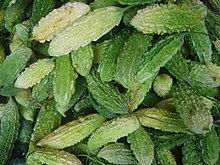Momordica
| Momordica | |
|---|---|

| |
| Bitter melon (Momordica charantia) | |
| Scientific classification | |
| Kingdom: | Plantae |
| Clade: | Tracheophytes |
| Clade: | Angiosperms |
| Clade: | Eudicots |
| Clade: | Rosids |
| Order: | Cucurbitales |
| Family: | Cucurbitaceae |
| Subfamily: | Cucurbitoideae |
| Tribe: | Momordiceae H. Schaef. & S.S. Renner 2011 |
| Genus: | Momordica L. |
| Species | |
|
See text | |
| Synonyms | |

Momordica is a genus of about 60 species of annual or perennial climbers herbaceous or rarely small shrubs belonging to the family Cucurbitaceae, natives of tropical and subtropical Africa and Asia and Australia. Most species produce floral oils[citation needed] and are visited by specialist pollinators in the apid tribe Ctenoplectrini. A molecular phylogeny that includes all species is available (Schaefer and Renner, 2010).
Cultivation and uses
Some Momordica species are grown in cultivation for their fleshy fruit, which are oblong to cylindrical in shape, orange to red in colour, prickly or warted externally, and in Momordica charantia burst when ripe, generally with elastic force, into irregular valves.
Momordica can be cultivated in 5 litre vases or jardinière and is hardly susceptible to plagues. After seeding, Momordica develops leaves in about 11 days and flowers after 40 to 50 days. After fertilisation, the Momordica fruit will be developed in about 10 days.[1]
Momordica charantia (bitter melon, Mandarin Chinese: kù guā 苦瓜) is native to Africa but has been used in Chinese folk medicine for centuries as a 'bitter, cold' herb, and has recently been brought into mainstream Chinese medicine as well as natural medical traditions around the world. Recent research has shown that the immature fruit might have some antibiotic, anticancer, and antiviral properties, particularly well suited for use in treatment of malaria, HIV, and diabetic conditions.[citation needed] The use of Momordica fruit is contraindicated in a number of conditions, especially pregnancy.[citation needed]
The effect of Momordica charantia on glucose and insulin concentrations was studied in nine non-insulin-dependent diabetics and six non-diabetic rats. These results show that it might improve glucose tolerance in diabetes but much more research is needed. Doctors supervising Asian diabetics should be aware of the fruit's hypoglycemic properties.[2][3][4][5]
Accepted species
References
- ^ Takeguma, Massahiro. "Culivo do Nigarui". Retrieved 20 May 2013.
- ^ British Medical Journal-Clinical Research 282(6279); 1823-4 6 June 1981.
- ^ J Ethnopharmacol 2003; 88(1): 107-111
- ^ Acta Biologica et Medica Germanica 41(12):1229-40 1982
- ^ Jiratchariyakul, W.; et al. (2001). "HIV inhibitor from Thai bitter gourd". Planta Med. 67 (4): 350–3. doi:10.1055/s-2001-14323. PMID 11458453.
- ^ GRIN. "Species in GRIN for genus Momordica". Taxonomy for Plants. National Germplasm Resources Laboratory, Beltsville, Maryland: USDA, ARS, National Genetic Resources Program. Retrieved October 22, 2009.
- ^ "Plant Name Query Results for Momordica". IPNI. Retrieved October 22, 2009.
- Schaefer, H.; Renner, S. S. (2010). "A three-genome phylogeny of Momordica (Cucurbitaceae) suggests seven returns from dioecy to monoecy and recent long-distance dispersal to Asia". Molecular Phylogenetics and Evolution. 54 (2): 553–560. doi:10.1016/j.ympev.2009.08.006. PMID 19686858.
